4.5 Sri Lanka
| Reports - Rapid Situation and Response Assessment South Asia |
Drug Abuse
4.5 Sri Lanka
4.5.1 Sample description
In Sri Lanka, 1,045 drug users (11% of the total sample of 9,465 drug users from South Asian countries) participated in the RSRA. Table 26 describes the socio-demographic characteristics of the drug users from Sri Lanka.
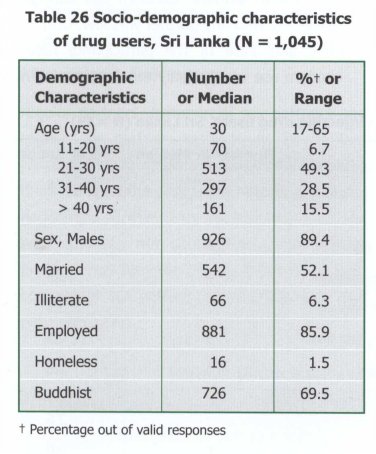
Many drug users (49%) who participated in the survey were in the age group of 21-30 years with a median age of 30 years (range 17-65). Only 11% female drug users were recruited for the assessment. More than half (52%) of the drug users were married, a small proportion (6°/0) were illiterate, 86°/0 were employed and 2°/0 were homeless.
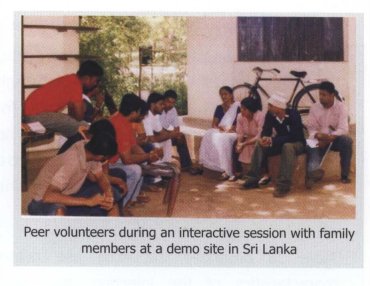
4.5.2 Drug use and risk behaviours
Table 27 describes the types of drugs used by the ever and current users. In terms of ever use of drugs, alcohol, cannabis and heroin were the most commonly used drugs. Most drug users (93%) were currently using heroin by non-injecting method (smoking), followed by the use of alcohol (81°/0), cannabis (80°/0) and propoxyphene (36%). Users were initiated to alcohol and cannabis before the age of 19 years and the age of onset for opioids like opium, heroin and buprenorphine was after 20 years.

Of the 1,045 drug users who participated in the assessment in Sri Lanka, 636 (62%) used drugs in groups always or at times. Twenty-eight percent of them used drugs with one to five friends. Changing drug using groups was not uncommon and was reported by almost a third of drug users (32°/0). The median frequency of drug use in the sample was three (range: 1-20).
Table 28 describes the drug use related characteristics of the injecting drug users (N = 39). A small proportion (18°/0) of them injected a cocktail of drugs and an equal number (18°/0) of IDUs were current injectors. Among the IDUs, the median frequency of injecting was five (range 2-8). More than two-thirds (64%) of the drug users switched to injecting from non-injecting methods of drug administration. Lending and borrowing of syringes and needles was uncommon and was reported by 10°/0 and 5°/o of the participants respectively during the last injection episode. Only 8°/o of the participants reported cleaning their injection equipment before using with others during the last time they injected with others. A very small proportion (3°/0) of the drug users reported abscesses during the past 6 months. Fifty-six percent of the drug users had stopped injecting and reverted back to non-injecting methods of administration.
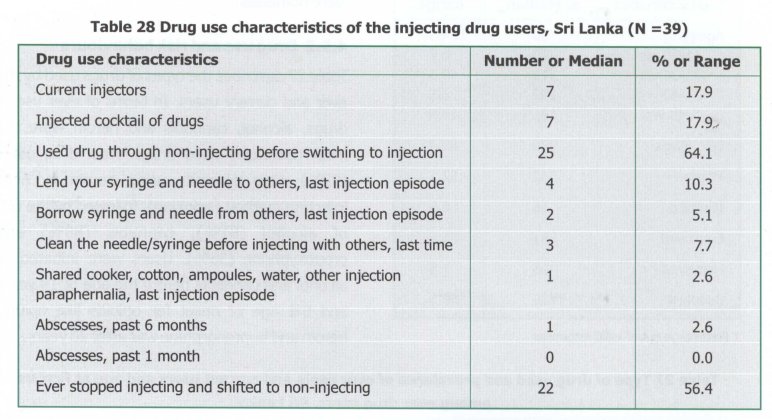
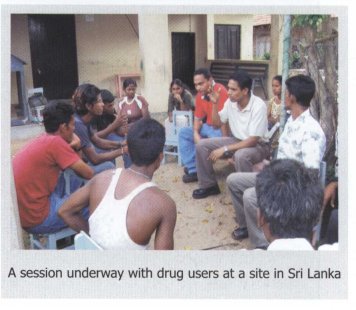
Table 29 describes the sexual behaviour characteristics of the drug users who participated in the assessment. Most (95%) of the participants had sexual experience and the median age at first sex was 19. During the past year, the participants had a median number of two sexual partners. Condom use during last sexual act with any partner was low. Only 31%, 2 8 % and 1 4 % of the participants reported condom use with casual, non-commercial, non-regular partners, commercial sex partners and regular sex partners respectively. Twenty-two percent of the drug users reported anal sex and a third (33°/o) of the drug users reporting anal sex had a male partner. Drug use before the last sex with casual, non-commercial, non-regular partners was common (46%), followed by with commercial sex partner (43%) and regular sex partners (32%).

4.5.3 Adverse health consequences
It can be observed from Table 30 that the participants reported the following symptoms related to sexually transmitted infections during the past 12 months: discharge from the genitalia (7°/0); ulcer on/around genitalia (7%); and, pain/burning sensation during urination (12°/0). More than three-fourths (79°/o) of the drug users sought any treatment for any of the above symptoms during the past year.

4.5.4 Knowledge and attitude in relation to HIV/AIDS
Variables related to knowledge and attitudes to HIV/AIDS of the drug users who participated in the study are described in Table 31. Most (890/0) of the drug users were aware of HIV/AIDS. The knowledge of HIV transmission among the participants were: through contaminated injection equipment (77°/0); by blood transfusion from an infected person (85%); from HIV infected mother to her unborn child (65°/0); and, through breast-feeding by a HIV infected mother (62°/0). A small proportion (16%) of the drug users believed that they could recognise an HIV infected person by appearance. Only 60% of the drug users knew that condoms protect against HIV. Only 36°/0 of the drug users believed that they were at-risk of getting infected with HIV. Even though, a small (16%) proportion of drug users had been tested for HIV, among those not tested as yet, more than a half (53%) desired to undergo HIV test. The drug users were of the opinion that they would share results of their HIV test with to their regular partner if tested positive (28°/0) or negative (300/0). Less than a fourth of the drug users (23°/o) had been treated ever for drug dependence. Thirty-eight percent of the drug users had been approached by someone to provide HIV prevention information. Many drug users believed that they would be treated differently from the non-drug using persons in the health care settings. Sixteen percent and 45% of the drug users were of the opinion that they would be treated as well as the non-drug users in government health care settings and private health care settings respectively.
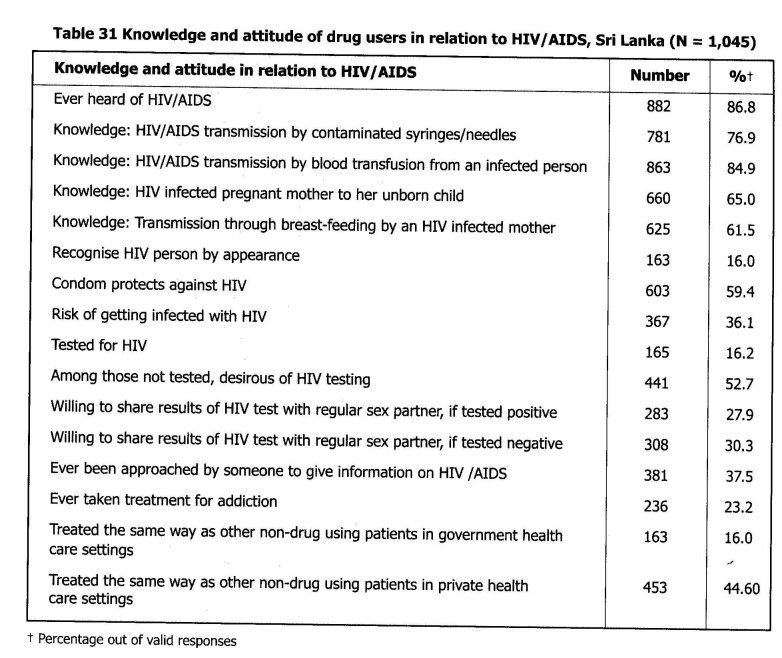
4.5.5 Regular sex partners of drug users
A total of 708 regular sex partners were recruited and completed a rapid situation and response assessment questionnaire. The median age of the regular sex partners was 30 years (range 16- 77 years). About three-fourths of them (73°/o) were married and 10% were illiterate. Twenty-eight percent of the regular sex partners of drug users were employed and 11% were engaged in commercial sex. About a fourth (23%) of the regular sex partners used drugs. Only 12°/o of the
regular sex partners had used condoms during their last sexual act. Eleven percent of the regular sex partners used drugs before their last sexual act. A small proportion (6°/o) of the sex partners reported anal sex. White vaginal discharge (6°/o), genital ulcer (2°/o) and pain/burning sensation while passing urine (11%) was not uncommon. Seventy percent of the regular sex partners had heard of HIV/AIDS but only 17% of the regular sex partners believed that they were at-risk for acquiring HIV. Only, about a fifth (21%) of the sex partners believed that condoms protected against HIV infection. A small proportion (14%) of the sex partners had undergone HIV test.
4.5.6 Recommendations
• More than half of the drug users were married and hence all drug user interventions should target the drug users as well as their regular sex partners.
• As most of the drug users were literate, appropriate HIV prevention IEC materials should be developed to reach out to the literate populations.
• As most of the drug users were using heroin by non-injecting method of administration, interventions to prevent transitions to injecting should target the non-injecting drug users.
• Many drug users were young persons between 21-30 years of age and were sexually active with a median number of two sexual partners. Anal sex with other males was not uncommon. Despite the knowledge that condoms protect against HIV, condom use with any partner, in particular, regular sex partners was low. Interventions targeting drug users should always target sexual behaviour and promote consistent condom use with all sexual partners.
• Drug use before sex with casual and commercial sex partner was common and since drug use can compromise on the safe sex, this aspect should be considered in HIV prevention interventions.
• Symptoms of sexually transmitted infections were not uncommon; screening for STIs and effective STI care should be integral components of HIV prevention efforts for drug users.
• Most respondents were aware of HIV, and many were knowledgeable about needle related HIV transmission as well as unsafe blood transfusion; but the knowledge relating to HIV transmission by mother-to-child transmission and breastfeeding was inadequate. About two-thirds of the drug users did not believe that they are at-risk of getting infected with HIV and hence effort should be directed towards enhancing the risk perception.
• Focus should be on providing HIV testing for the drug users given the fact that most drug users had not been tested for HIV, and those not yet tested desired to get tested for HIV.
• Drug users felt that they were not being treated well both in government and private health care settings. Services should, therefore, become more user-friendly for the drug users in order to attract and retain them in services.
| < Prev | Next > |
|---|












